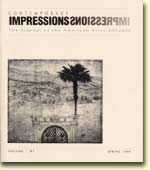![]() Home
Home
![]() The Alliance
The Alliance
![]() Exhibits
Exhibits
![]() Gallery
Gallery
![]() Resources
Resources
![]() Calendar
Calendar
![]() Competitive Exhibits
Competitive Exhibits
![]()
![]() Advocacy
Advocacy
![]() Technical Articles
Technical Articles
![]() Supplies
Supplies
![]() Links
Links
![]() Library
Library
Prints & Politics
by the editor, Dr. Carol Pulin
Reprinted from Contemporary Impressions, vol. 3 #2, Fall 1995, pages 14-15. © 1995 American Print Alliance
The expanding use of computers for graphic arts has led to increased "borrowing" of images: scanning with today's digital equipment is even easier than old-fashioned photography for transferring images from one medium to another. The transfer is usually done for reproduction, whether or not the original image is changed in some way — intensifying colors or applying a software "filter" to look like pastels, for example. How much alteration of one's own previously-created image is enough to justify calling it a new image instead of a copy? How much transformation of someone else's image (even with permission) is necessary for an artist or designer to claim the result? Computers aren't the issue, originality is.
Ethical and aesthetic questions about "appropriation" are closely related to ideas about artistic intent and the "original print." Basic, philosophical issues need to be considered by both sides of the art world — creators and consumers. Printmakers could, perhaps should, take the lead. Otherwise, definitions and rules will be set by those whose interest is less likely to be encouragement of the arts than financial.
There is a long history of definitions set by scholarly groups. In 1960, the Print Council of America (professors and curators, no dealers, no artists) published What Is an Original Print? It accepted only prints for which the artist designed and created the matrix, permitting electric tools and even photographic techniques, but no copyists — though others could print with the artist's supervision. This principle was contained in the 1960 resolution of the UNESCO artists' organization. Carl Zigrosser reiterated the essentials in this definition of an original print:
- The artist alone has created the master image in or upon the plate, stone, wood block or other material, for the purpose of creating the print;
- The print is made from the matrix by the artist or following his directions; and
- The finished print is approved by the artist.
[Carl Zigrosser in A Guide to the Collecting and Care of Original Prints, Print Council of America, New York, 1965.]
The International Fine Print Dealers Association has proposed its own definitions and standards, revised to keep up with the times (and with what the dealers are selling). "Founded in 1987 by a group of the world's foremost print dealers, the Association was established to protect collectors and buyers." It claims to make the most original contribution to the literature by establishing categories for the artist's "involvement" in the creative process. The stated advantage is "a new standard for judging prints without using the term 'original' ... Because of its universal scope, the system we have created will remain valid for whatever hybrid and unusual kinds of prints even the most unorthodox artists manage to produce." The essay "does not say which kinds of prints are better than others on the basis of techniques used in making them, the artist's personal involvement, or anything else," and "it does not say which kinds of prints are more valuable." The booklet states, "There is no 'line of legitimacy' drawn to separate good, fine, original or authentic prints from bad, fake or reproductive ones." The categories:
- The artist alone prepares and creates the matrix.
- The artist and collaborator(s) prepare and create the matrix. The collaborator usually contributes technical expertise, or performs laborious, time-consuming tasks.
- The artist does not work on the matrix. The physical labor is performed by a collaborator. The artist provides a design to be copied and is critically involved in directing the work, suggesting modifications and approving the results.
- The artist has no meaningful involvement in the matrix production. Here the artist, or agent of the artist, supplies a printmaker with a design to be reproduced, as faithful to the original as the chosen print medium will allow.
- The artist, or an agent of the artist, authorizes the reproduction of one of his or her existing works.
- A reproduction is made without the permission of the artist or agent of the artist.
- A print is made from the primary matrix without the artist's authorization.
[Sylvan Cole et al., "What is a Print?" in International Fine Print Dealers Association Directory, New York, 1995. The British Standard Institute plans to adopt a "Classification of Prints" which is essentially identical.]
Contemporary artists unhappy with the definitions set by others, who seek recognition of original work and creative roles, should express their views to dealers, curators, private collectors and the public. The American Print Alliance is initiating dialogue, presenting the views of the print community, and building consensus for the acknowledgement of rights and responsibilities. The Alliance assures that printmakers have a clear and cogent voice in the debate.
To order additional copies of this publication, Laws concerning Documentation and Disclosure in the Sale of Prints and other Multiples, please send US $5 for printing, postage and handling to:
American Print Alliance
302 Larkspur Turn
Peachtree City GA
30269.
